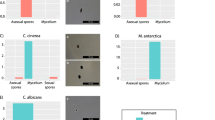Abstract
Large numbers of resting spores of Thalassiosira nordenskioeldii Cleve and Detonula confervacea (Cleve) Gran were produced when these species were grown at low levels of ammonia and nitrate. The production of resting spores by T. nordenskioeldii was inversely related to temperature. At 0° and 5°C between 68 and 96% of the total cells were resting spores, while at 15°C resting spores were not produced. Resting spores of both species would not survive 7 days in the dark at 20°C. At 0°, 5°, 10° and 15°C, the length of time that the resting spores of both T. nordenskioeldii and D. confervacea remained viable was inversely related to temperature. At 0°C, T. nordenskioeldii remained viable for 576 days. The data suggest that the production of resting spores by these two species does not aid them in the survival of unfavorably high temperatures such as are found in temperate estuaries during the summer. Rather, they appear to be an adaptation for the survival of long periods of darkness in polar regions.
Similar content being viewed by others
Literature Cited
Antia, N.J. and J.Y. Cheng: The survival of axenic cultures of marine planktonic algae from prolonged exposure to darkness at 20°C. Phycologia 9, 179–183 (1970)
Bigelow, H.B.: Plankton of the offshore waters of the Gulf of Maine. Bull. Bur. Fish., Wash. 40, 1–509 (1926)
Braarud, T.: A note on the phytoplankton of the Gulf of Maine in the summer of 1933. Biol. Bull. mar. biol. Lab., Woods Hole 67, 76–82 (1934)
Bursa, A.S.: The annual oceanographic cycle of Igloolik in the Canadian Arctic. II. The phytoplankton. J. Fish. Res. Bd Can. 18, 563–615 (1961)
Durbin, E. G.: Studies on the autecology of the marine diatom Thalassiosira nordenskioeldii Cleve. I. The influence of daylength, light intensity, and temperature on growth. J. Phycol. 10, 220–225 (1974)
Ettl, H., D.G. Mueller, K. Neumann, H.A. von Stosch und W. Weber: Vegetative Fortpflanzung, Parthogenese und Apogamie bei Algen. Handb. PflPhysiol. 18, 597–776 (1967)
Gran, H.H. and T. Braarud: A quantitative study of the phytoplankton in the Bay of Fundy and the Gulf of Maine (including observations on the hydrography, chemistry, and turbidity). J. biol. Bd Can. 1, 279–476 (1935)
Groentved, J. and G. Seidenfaden: The phytoplankton of the waters west of Greenland. Meddr Grønland 82, 1–380 (1938)
Gross, F.: The life history of some marine plankton diatoms. Phil. Trans R. Soc. (Ser. B) 28, 1–47 (1937)
Guillard, R.R.L.: Organic sources of nitrogen for marine centric diatoms, In: Symposium on marine biology, pp 93–121. Springfield, Illinois: C.C. Thomas 1963
Heimdal, B.R.: Further observations on the resting spores of Thalassiosira constricta (Bacillariophyceae). Norw. J. Bot. 21, 303–307 (1974)
Hellebust, J.A. and J. Terborgh: Effects of environmental conditions on the rate of photosynthesis and some photosynthetic enzymes in Dunaliella tertiolecta. Limnol. Oceanogr. 12, 559–567 (1967)
Jitts, H.R., C.D. McAllister, K. Stephens and J.D.H. Strickland: The cell division rates of some marine phytoplankters as a function of light and temperature. J. Fish. Res. Bd Can. 21, 131–157 (1964)
Pratt, D.M.: The phytoplankton of Narragansett Bay. Limnol. Oceanogr. 4, 425–440 (1959)
—: The winter-spring diatom flowering in Narragansett Bay. Limnol. Oceanogr. 10, 173–184 (1965)
Rahat, M. and I. Dor: The hidden flora of a lake. Hydrobiologia 31, 186–192 (1968)
Shonting, D.H. and C.J. Cook: On the seasonal distribution of temperature and salinity in Rhode Island Sound. Limnol. Oceanogr. 15, 100–112 (1970)
Smayda, T.J.: Phytoplankton studies in lower Narragansett Bay. Limnol. Oceanogr. 2, 342–359 (1957)
—: Experimental observations on the influence of temperature, light and salinity on cell division of the marine diatom, Detonula confervacea (Cleve) Gran. J. Phycol. 5, 150–157 (1969)
—: The growth of Skeletonema costatum during a winter-spring bloom in Narragansett Bay, R.I. Norw. J. Bot. 20, 219–247 (1973)
— and B. Mitchell-Innes: Dark survival of autotrophic, planktonic marine diatoms. Mar. Biol. 25, 195–202 (1974)
Umebayashi, O.: Preservation of some cultured diatoms. Bull. Tokai reg. Fish. Res. Lab. 69, 55–61 (1972)
Author information
Authors and Affiliations
Additional information
Communicated by M.R. Tripp, Newark
Rights and permissions
About this article
Cite this article
Durbin, E.G. Aspects of the biology of resting spores of Thalassiosira nordenskioeldii and Detonula confervacea . Mar. Biol. 45, 31–37 (1978). https://doi.org/10.1007/BF00388975
Accepted:
Issue Date:
DOI: https://doi.org/10.1007/BF00388975




